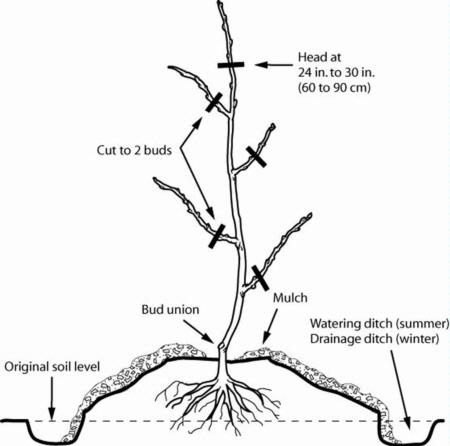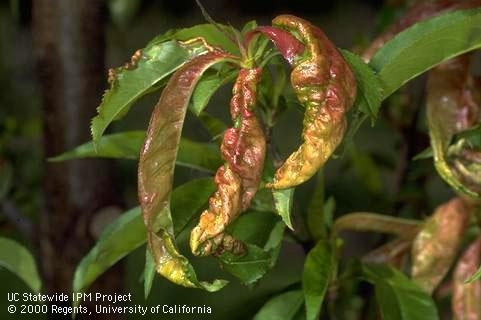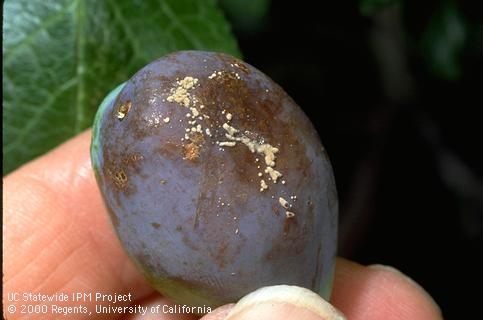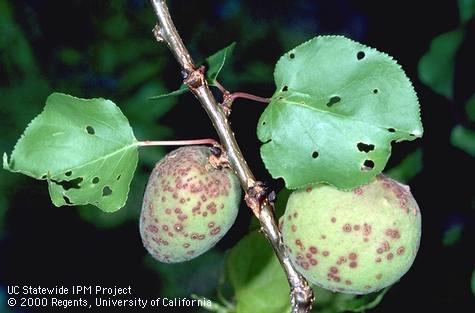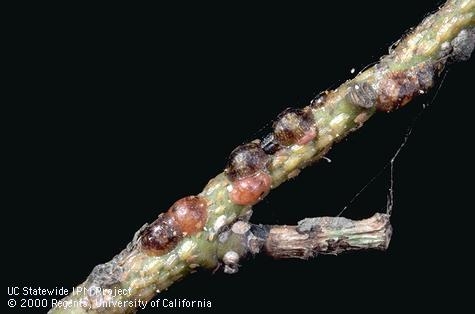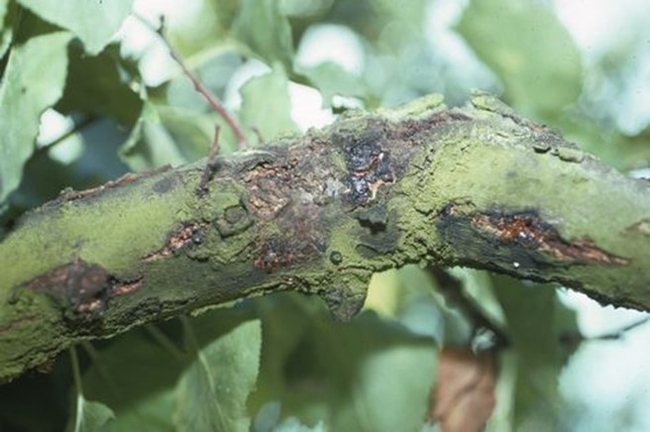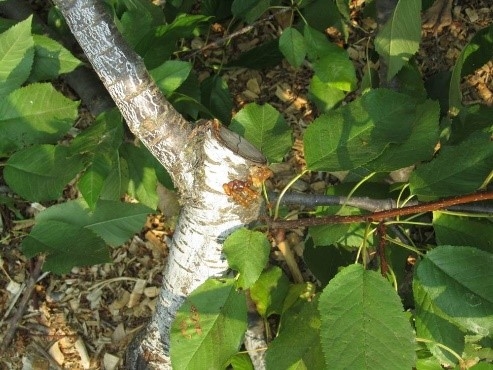- Author: Help Desk Team
Winter is an ideal time to plant a fruit tree. Although it requires some patience, success is best using bare root trees. There are many advantages: the trees are lighter and easier to handle; you can get a good look at the roots; they cost less than leafed-out potted trees; the tree is dormant and less apt to be stressed by handling; and the roots don't have to adapt again to new soil. The main disadvantage is that you should get the tree in the ground within a few days after purchase, and it may take 2–3 years before some trees produce fruit.
Fruit trees are an investment and deserve some thoughtfulness to ensure you plant the right tree (appropriate for your climate zone) in the right location (good drainage, minimum 6 hours sun per day). Digging the planting hole before buying the tree will let you check for drainage and an adequate amount (2–3 feet deep minimum) of soil. Here is a website showing how to test soil including drainage: https://marinmg.ucanr.edu/BASICS/SOIL_813/evaluate/
Selecting a healthy bare root tree is critical to get your investment off to a good start. Buy your tree from a reputable nursery that has a wide selection. You don't want a tree with roots that have been in a container too long. These roots may be kinked and will look like they are circling the root ball. These roots tend not to spread and that deprives your tree of needed nutrients.
When preparing the hole for your tree, follow the steps as described in the article linked below to give the roots room to spread and to prevent the graft site from sinking below soil level. Backfill with native soil. As you can see from the diagram below, most of the root ball should be above the original soil level to avoid crown rot. The tree will also settle.
And unless you want a huge tree with more fruit than most families could possibly eat, prune the trunk back to about knee height after planting. This takes some courage, but your tree will reward you with plenty of fruit that is easy to reach. Wait until the weather will be dry for at least several weeks to prune apricots, apriums, and cherries.
Other considerations are pollination requirements, ultimate tree size, chill hours, and disease susceptibility. Pollination is necessary for good fruit production. Some fruit trees have flowers with both male (anthers) and female (pistils) organs and can self-pollinate, such as persimmons and Bartlett pears. Other trees have flowers with both male and female organs but cannot self-pollinate and will require a second tree planted within 100 feet for fruit production, such as many apple varieties and Asian pears. Still others have separate male and female flowers.
Deciduous fruit and nut trees require a certain number of “chill hours” below 45°F to produce. It is important to select only varieties that have chill hour requirements equal to or lesser than the chill hours listed for your area. This reference discusses chill hours and has links to fruit tree requirements for Contra Costa County: https://ccmg.ucanr.edu/files/77176.pdf
It's important to know which diseases and pests a particular fruit tree is susceptible to. For example, apricots and their crosses such as aprium and pluot are prone to infection by the Eutypa fungus and unlike most deciduous trees, should be pruned in late summer before the weather gets damp. Check the reference below. These references have links and information regarding fertilization, pollination, pests and diseases, and characteristics of various fruit trees.
Despite our recent rains, we are still in a drought. Most fruit trees need substantial amounts of water to become established and as they mature and produce fruit. This link has information about drought tolerant fruit trees, shrubs and vines: https://crfg.org/wp-content/uploads/Drought-Tolerant-Fruiting-Trees-Shrubs-and-Vines-Presentation.pdf
Articles with step-by-step planting guides:
• https://sonomamg.ucanr.edu/Food_Gardening/Additional_KG_Articles/Planting_Bare-root_Fruit_Trees/
• https://ucanr.edu/blogs/blogcore/postdetail.cfm?postnum=46072
• https://ucanr.edu/blogs/blogcore/postdetail.cfm?postnum=38836
Excellent video with step-by-step planting guide (UC does not recommend any particular business but this nursery has good videos and does not advertise its products):
• https://www.youtube.com/watch?v=fP-2TGlNo50
More information:
• The Big Picture: https://homeorchard.ucanr.edu/
• Fruit trees for Contra Costa County – great reference to help you decide what to buy, and a pollinating guide: https://ucanr.edu/sites/ccmg/files/228958.pdf
• Fruit tree pests and diseases: http://ipm.ucanr.edu/PMG/GARDEN/fruit.html
Help Desk of the UC Master Gardener Program of Contra Costa County (EAS)
- Author: Help Desk Team
Now that the leaves have fallen, or mostly fallen, from your backyard fruit trees, are you wondering whether you should apply dormant sprays?
“Dormant sprays” or “delayed dormant sprays” are terms used for the application of pesticides when the tree is dormant or just coming into bud swell. The pesticide could be a fungicide used to help manage fungal disease or a horticultural oil or oil in combination with insecticides to kill insects.
Don't assume that you need dormant spray. Before reaching for the spray, first determine whether your trees have previously had a disease or serious insect pest problem that can be managed with dormant sprays. Have you already tried all non-chemical recommendations for lessening the problem? Finally, evaluate the amount of damage from the disease or insect pest you experienced in the prior growing season to decide whether a pesticide is really needed.
Fruit tree diseases that can be managed by applying a fungicide dormant spray include peach leaf curl, brown rot, and shot hole disease.
Peach leaf curl affects only peach and nectarine trees. It shows up in spring after the tree has leafed out. Leaves are thickened, curled, and colored red or yellow instead of normal green.
If your tree has had significant peach leaf curl in prior years, dormant spraying with a fixed copper spray just after all the leaves have fallen from the tree (usually December to January in our County) may prevent or reduce the severity of the disease. For information on managing peach leaf curl, see https://ipm.ucanr.edu/PMG/PESTNOTES/pn7426.html/
Brown rot (Monilinia) is a fungal disease that can affect peaches, plum, cherries, apricots, and nectarines. In the spring blossoms on infected trees shrivel and die, often clinging to the twigs. Leaves at the base of infected twigs may also turn brown and die. Fungal spores attach themselves to developing fruit and show up as brown or tan spots on the surface of the fruit.
If your trees had significant fruit loss from brown rot in the prior growing season, a dormant spray of a copper-based fungicide may help. Apply it at the pink bud stage while flower buds are still tightly curled and pink in color. For more information on brown rot, see http://ipm.ucanr.edu/PMG/GARDEN/FRUIT/DISEASE/aprbrownrot.html.
Shot hole (coryneum blight) can affect plums, nectarines, peaches, cherries, and especially apricots. It shows up as small reddish holes on leaf surfaces. Often the holes turn brown and drop out. Fruits may also be infected. Where disease has been severe and cultural steps haven't helped, a fungicide spray following complete leaf drop may be needed. See http://ipm.ucanr.edu/PMG/GARDEN/FRUIT/DISEASE/shothole.html.
Insects that can be managed with dormant sprays of horticultural oils or oils mixed with insecticides include scale, aphids and spider mites. Don't spray unless you have confirmed that the insects are present in damaging numbers and cannot be controlled by other means. Keep in mind that spraying may also kill beneficial insects which are the first line of defense against insect pests. More information on controlling these insect pests can be found at these UC websites: http://ipm.ucanr.edu/QT/scalescard.html, http://ipm.ucanr.edu/QT/aphidscard.html and http://ipm.ucanr.edu/QT/spidermitescard.html.
Before spraying, read and carefully follow the label instructions on the pesticides you use, including wearing recommended protective gear.
If you want to add another fruit tree to your home orchard, stay tuned for an upcoming Blog article on Selecting and Planting Bare Root Fruit Trees to be published in December. If you want to be sure you can get a specific variety of fruit tree, contact your local nursery. The nursery may be able to reserve it for you, or if necessary, special order it for you.
Help Desk of the UC Master Gardener Program of Contra Costa County (TKL)
- Author: Help Desk Team
Prune Apricot and Cherry Trees in August
If you have apricot, cherry, or related hybrid tree varieties such as aprium and pluot in your yard, plan to prune them before the end of August. This timing will help prevent infection by a deadly fungal disease called Eutypa Dieback that can kill these trees as well as grape vines.
When infected by Eutypa, branches or entire trees wilt and die suddenly, often with the leaves still attached.
Apricot tree with branch killed by Eutypa
Signs that your tree may be infected by Eutypa include darkly discolored cankers on the branches and oozing of amber colored gummy sap.
Eutypa cankers on apricot branch
Oozing Sap on Cherry Tree from Eutypa Infection
[Editorial Note: apricot photos downloaded from UC Repository. Cherry tree photocopied from UC ANR blog article by Chuck Ingels, UCCE Sacramento, https://ucanr.edu/blogs/blogcore/postdetail.cfm?postnum=16014 ]
Many other varieties of trees and shrubs can become infected with the Eutypa fungus without showing disease symptoms or progressing to the dieback stage. These other tree and shrub varieties can serve as store houses for the Eutypa pathogens that could potentially spread to your grape vines and apricot, cherry, aprium and pluot trees. Trees and shrubs that can serve as reservoirs for the disease include almond, apple, blueberry, crabapple, honeysuckle, kiwi, oleander, pear, and certain native plants such as big leaf maple, California buckeye, ceanothus, and willow.
Eutypa disease is spread from an infected tree, shrub or vine to uninfected trees by splashing water from sprinklers or rain. The splashing water allows the fungal spores to enter through pruning or other wounds. Pruning vulnerable tree varieties by the end of August allows pruning wounds to heal and close before the typical start of the rainy season in Contra Costa County in late October. Also, avoid using sprinklers near recently pruned trees since water from sprinklers can also spread infections. Using these precautions will reduce the risk of infection for your trees.
Studies have shown that the Eutypa pathogens can also be spread on pruning tools that have been used to prune infected trees and shrubs. To prevent such transmission, be sure to disinfect your pruning tools before and after pruning.
To disinfect tools, soak them for thirty minutes in a 10% bleach solution (nine parts water to one part bleach). Bleach is corrosive so be sure to rinse the tools thoroughly with water after soaking. Then oil them. The bleach solution loses 50% of its effectiveness after two hours, so be sure to use a freshly mixed batch.
As an alternative to bleach, you can disinfect pruning tools with 70% isopropyl alcohol. Just spray it on your tools and it will kill any pathogens almost immediately. Alcohol is not corrosive, so you don't need to rinse it off tools.
An internet search for “how to prune apricot [or cherry, aprium or pluot] trees” will help you find videos that demonstrate good pruning techniques. Just be aware that most pruning videos are filmed when the trees are dormant. With no leaves, the branches can be more easily shown in the video to demonstrate pruning techniques. In California, you don't want to wait until the dormant season to prune these vulnerable trees because that increases the risk of an Eutypa infection. So, you'll need to adapt the pruning techniques to a tree that still has leaves.
For more information on Eutypa disease, visit this University of California IPM website: http://ipm.ucanr.edu/PMG/GARDEN/FRUIT/DISEASE/eutypadieback.html
Fertilizing Fruit Trees and Information on Chill Hours"
Advice for the Home Gardener from the
Help Desk of the UC Master Gardeners of
Contra Costa County
Home Gardener Request: We're finally jumping into fully caring for our mini-orchard here in Mid-County. Could you please point us to a good reference book for that task... Also, we are getting acquainted with chill hours for growing and/or buying various fruit trees, especially for apple, plum and pear trees. Where can we find local info on chill hours?
CCMG Help Desk Response: Thanks for calling the UC Master Gardener Program Help Desk this morning with your questions about what and how to feed your apple, plum and pear trees and year to date chill hours for your area.
After some further thought, I'd like to suggest that you may want to complete a soil test of your orchard to see what your soil may be lacking before fertilizing your trees this spring as that will drive what and how much to feed.
I found that the UC Home Orchard: Growing Your Own Deciduous Fruit and Nut Trees book supports soil testing before adding potentially unnecessary fertilizers to your soil:
Although deciduous fruit trees require many nutrients for tree growth and fruit production, those grown in backyard settings in typical sandy loam to clay loam soils with proper irrigation rarely need to be fertilized. Nutrient deficiencies, when encountered, are generally limited to nitrogen, potassium, iron, and zinc, and on rare occasions, boron. Unless your soil has a known nutrient deficiency, regular applications of fertilizer usually are not necessary in a mature orchard.
Below is a link to a list of soil testing companies for you to choose from. When you contact one of the labs, they will give you instructions on how to take the sample and prepare it for shipping. Some of the labs listed also have helpful information on how to interpret the results including the amounts of necessary additives your soil needs. Soil testing companies: https://ucanr.edu/sites/ccmg/files/51308.pdf
Below is a link to information from the UC California Backyard Orchard website. It includes information on common elements for normal growth and amounts to feed by age of the tree rather than size: http://homeorchard.ucanr.edu/The_Big_Picture/Fertilization/
The links below include helpful seasonal information for growing fruit trees:
Apples & Pears: Calendar of Operations for Home Gardeners: http://homeorchard.ucdavis.edu/7258.pdf
Plums: Calendar of Operations for Home Gardeners: http://homeorchard.ucdavis.edu/7262.pdf
And finally, here is the link I used to find current information on chill hours in Contra Costa County. I selected the El Cerrito Weather Station for a chill hour to date and historical information:
https://ucanr.edu/chillcalc/?controller=station&action=reportresults&STATION=213
You may want to consider purchasing The UC Home Orchard: Growing Your Own Deciduous Fruit and Nut Trees book as it was developed especially for backyard orchardists, rare fruit growers, and small-scale growers. It is available through various online booksellers and through the UCANR Catalog: https://anrcatalog.ucanr.edu/
I hope you find this information helpful. Please let us know if you have any additional questions.
Help Desk of the UC Master Gardener Program of Contra Costa County (SLH)
Notes: Contra Costa MG's Help Desk is available almost year-round to answer your gardening questions. Except for a few holidays (e.g., last 2 weeks December), we're open every week, Monday through Thursday for walk-ins from 9:00 am to Noon at 2380 Bisso Lane, Concord, CA 94520. We can also be reached via telephone: (925) 608-6683, email: ccmg@ucanr.edu, or on the web at http://ccmg.ucanr.edu/Ask_Us/. MGCC Blogs can be found at http://ccmg.edu/HortCoCo/ You can also subscribe to the Biog.
Client's Request: I'm a trapper in the Ag Department. We have been looking for plum bud gall mites in the county. I recently came across this plum tree with a huge growth or gall, it's 8" long and 7" wide on the underside of a branch, the tree is around 15 years old. Homeowner wants to know what it is and what should be done about it. The tree is in Pittsburg. Any ideas?
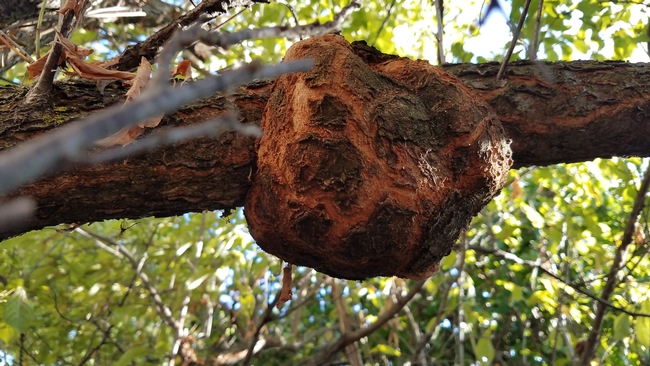
MGCC Help Desk Response: Thank you for contacting the UC Master Gardener Program Help Desk with your question about a very large gall on this 15 year old plum tree in Pittsburg.
I believe this is a gall caused by the bacterium Agrobacterium tumefaciens commonly referred to as crown gall mite or possibly Plum Bud Gall Mite (Acalitus phloeocoptes (Nalepa)). Crown gall, as its name implies, typically appears at the crown of a plant, where the trunk enters the soil but it also can infect the main trunk and side branches. Plum trees are among a long list of plants commonly infected by crown gall including many popular home garden fruit trees (pluots, etc.).
The surface of crown galls and wood underneath is the same color as healthy bark and wood. However, when cut with a knife, crown galls are softer than normal wood and lack the typical pattern of annual growth rings. Galls can be tiny and smooth on young plants but usually are rough and sometimes massive on older trees.
Crown gall appears to have a relatively minor effect on most older plants which is the situation you found. Since this tree is 15 years old and the gall appears to encompass a major part of the main branch I would suggest leaving it be. If the distal portion of the branch starts to decline then the branch can be removed back towards the trunk thereby removing the gall.
Without further inspection of the gall here in our office, another possibility is the Plum Bud Gall Mite (Acalitus phloeocoptes (Nalepa)) which are well described in the Santa Clara County UCCE link below.
Following is a link to a UC Integrated Pest Management website that explains crown gall http://ipm.ucanr.edu/PMG/GARDEN/PLANTS/DISEASES/crowngall.html
and here is a Santa Clara County UCCE link to Plum Bud Gall Mite:
http://mgsantaclara.ucanr.edu/files/300211.pdf
We could give a more conclusive response if you would bring a sample to our offices during our office hours described at the bottom of this response.
I hope your homeowner will be relieved. Good luck.
Help Desk of the UC Master Gardener Program of Contra Costa County (EDC)
Notes: Contra Costa MG's Help Desk is available almost year-round to answer your gardening questions. Except for a few holidays (e.g., last 2 weeks December), we're open every week, Monday through Thursday for walk-ins from 9:00 am to Noon at 2380 Bisso Lane, Concord, CA 94520. We can also be reached via telephone: (925) 608-6683, email: ccmg@ucanr.edu, or on the web at http://ccmg.ucanr.edu/Ask_Us/. MGCC Blogs can be found at http://ccmg.edu/HortCoCo/ You can also subscribe to the Biog.


